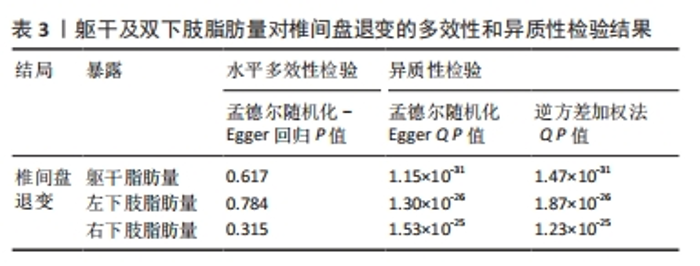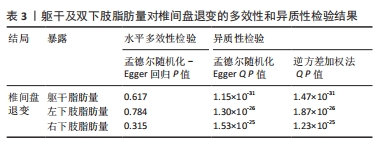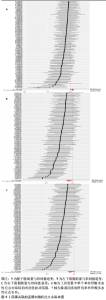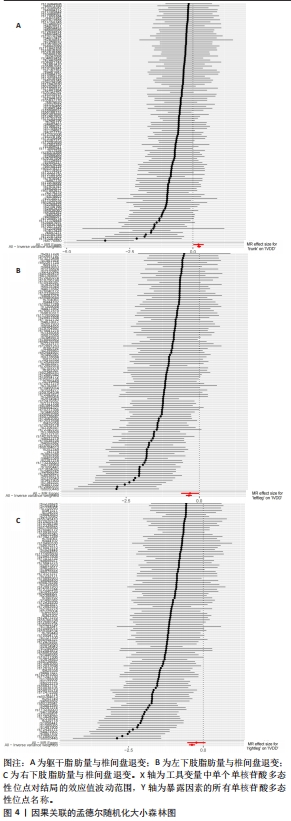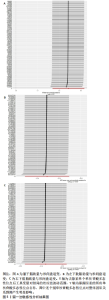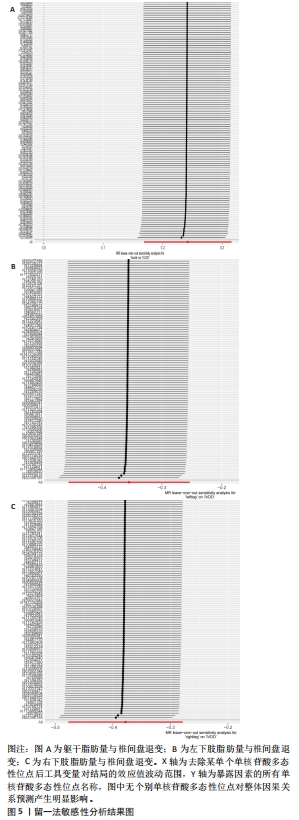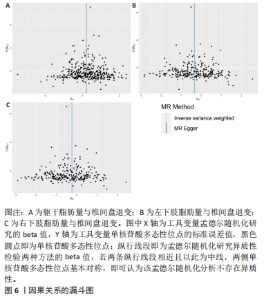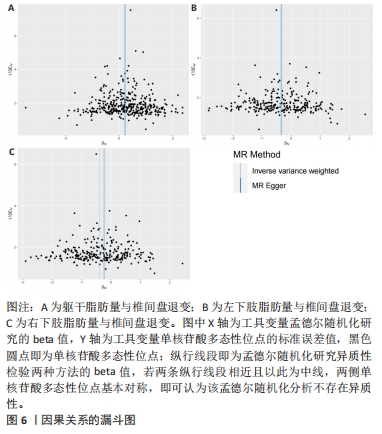Chinese Journal of Tissue Engineering Research ›› 2024, Vol. 28 ›› Issue (35): 5688-5694.doi: 10.12307/2024.825
Previous Articles Next Articles
Causal relationship between trunk and lower limb fat mass and intervertebral disc degeneration based on a Mendelian randomization analysis
Yang Jingyan1, Ma She1, Huang Renjun1, Wang Chaoyi1, Zhao Yuyang1, Yu Dong2
- 1The Third Clinical School of Beijing University of Chinese Medicine, Beijing 100029, China; 2The Third Clinical Hospital of Beijing University of Chinese Medicine, Beijing 100029, China
-
Received:2023-12-04Accepted:2024-01-04Online:2024-12-18Published:2024-03-15 -
Supported by:2022 Cultivation Project of the Ministry of Education Engineering Research Center for “Intelligent Treatment of Traditional Chinese Medicine Orthopaedic Injury and Sports Rehabilitation,” The Third Affiliated Hospital of Beijing University of Chinese Medicine, No. BZYSY-2022-GCYJZXQX-08 (to YD)
CLC Number:
Cite this article
Yang Jingyan, Ma She, Huang Renjun, Wang Chaoyi, Zhao Yuyang, Yu Dong. Causal relationship between trunk and lower limb fat mass and intervertebral disc degeneration based on a Mendelian randomization analysis[J]. Chinese Journal of Tissue Engineering Research, 2024, 28(35): 5688-5694.
share this article
Add to citation manager EndNote|Reference Manager|ProCite|BibTeX|RefWorks
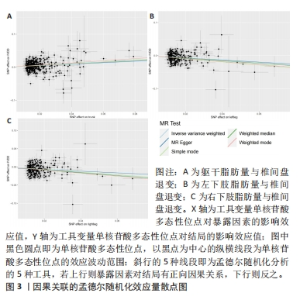
2.1 工具变量的选取 在使用clumped函数去除连锁不平衡后,躯干脂肪量剩余423个SNPs,左下肢脂肪量剩余288个SNPs,右下肢脂肪量剩余285个SNPs。经计算后得出此次研究每单个SNP对应的F值均> 10(躯干:27.36-795.01,左下肢:18.12-410.12,右下肢:18.76-430.60),即不存在弱工具变量偏倚。在Phenoscanner数据库中检索相关表型并剔除相关的SNPs,最后删除回文单核苷酸多态性后经MR-PRESSO分析无离群值,最终躯干脂肪量纳入347个SNPs、左下肢脂肪量纳入256个SNPs、右下肢脂肪量纳入255个SNPs作为工具变量来评估与椎间盘退变的因果关系。 2.2 躯干脂肪量与椎间盘退变的因果关系 逆方差加权法检测结果显示:OR=1.25,95%CI:1.15-1.35,P < 0.001;加权中值法检测结果显示:OR=1.28,95%CI:1.16-1.42,P < 0.001;MR-Egger检测结果显示:OR=1.32,95%CI:1.05-1.65,P=0.02;加权中位数法检测结果显示:OR=0.65,95%CI:0.50-0.85,P=0.002,以上方法结果P值均< 0.05,具有显著性意义。简单中位数法结果显示:OR=1.29,95%CI:0.90-1.84,P=1.29,结果无显著性意义,但是5种方法因果效应方向一致(OR值均> 1),散点图显示回归线无明显偏移,见图3,故提示躯干脂肪量与椎间盘退变有正向因果关系,躯干脂肪量升高是椎间盘退变发生的风险因素。"
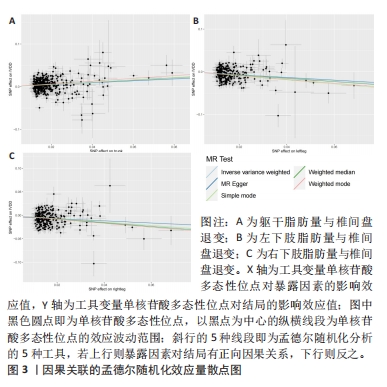
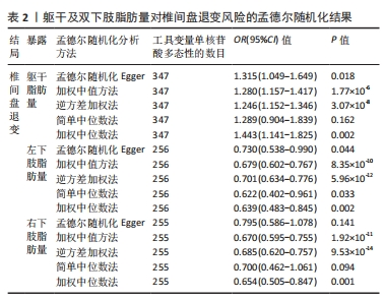
2.3 双下肢脂肪量与椎间盘退变的因果关系 在左下肢脂肪量与椎间盘退变的分析中,逆方差加权法具有显著性意义(OR=0.7,95%CI:0.63-0.78,P < 0.001),提示左下肢脂肪量与椎间盘退变有反向因果关系; 5种方法的因果效应方向一致。在右下肢脂肪量与椎间盘退变中:逆方差加权法、加权中值法与加权中位数法的结果均具有显著性意义,OR(95%CI)分别为0.69(0.62-0.76),0.68(0.60-0.76),0.65(0.50-0.85),P值均< 0.05,提示右下肢脂肪量与椎间盘退变有反向因果关系;简单中位数法(OR=0.7,95%CI:0.40-0.96,P=0.10)以及MR-Egger(OR=0.8,95%CI:0.59-1.08,P=0.14)结果无显著性意义,但5种方法的因果效应方向一致,散点图显示回归线无明显偏移,提示结果同前。综上,双下肢脂肪量与椎间盘退变有反向因果关系,双下肢脂肪量是椎间盘退变的保护因素,以上数据细节见表2。"
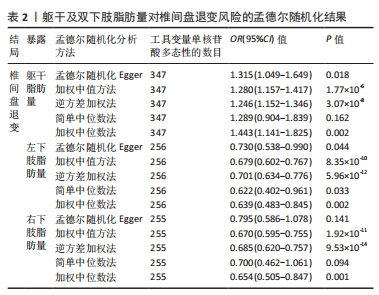
| [1] ZHENG CJ, CHEN J. Disc degeneration implies low back pain. Theor Biol Med Model. 2015;12:24. [2] DAMMERS R, KOEHLER PJ. Lumbar disc herniation: level increases with age. Surg Neurol. 2002;58(3-4):209-212; discussion 212-213. [3] HECHAVARRIA ME, RICHARD SA. Elucidating the focal immunomodulatory clues influencing mesenchymal stem cells in the milieu of intervertebral disc degeneration. Curr Stem Cell Res Ther. 2023;18(1):62-75. [4] TREFILOVA VV, SHNAYDER NA, PETROVA MM, et al. The role of polymorphisms in collagen-encoding genes in intervertebral disc degeneration. Biomolecules. 2021;11(9):1279. [5] KIRNAZ S, CAPADONA C, WONG T, et al. Fundamentals of intervertebral disc degeneration. World Neurosurg. 2022;157:264-273. [6] 徐波,黄泽灵,张龙,等.中国人群腰椎间盘突出症患病率的Meta分析[J].中医正骨,2023,35(9):17-23. [7] ZHAO CQ, LIU D, LI H, et al. Expression of leptin and its functional receptor on disc cells: contribution to cell proliferation. Spine (Phila Pa 1976). 2008;33(23):E858-E864. [8] GO O, FREEEMAN RH, REAMS GP, et al. Obesity hypertension: pathophysiological role of leptin in neuroendocrine dysregulation. Am J Med Sci. 2014;347(6):485-489. [9] DOWDELL J, ERWIN M, CHOMA T, et al. Intervertebral disk degeneration and repair. Neurosurgery. 2017;80(3S):S46-S54. [10] BERIKOL G, EKŞI MŞ, AYDIN L, et al. Subcutaneous fat index: a reliable tool for lumbar spine studies. Eur Radiol. 2022;32(9):6504-6513. [11] WANG M, YUAN H, LEI F, et al. Abdominal fat is a reliable indicator of lumbar intervertebral disc degeneration than BMI. World Neurosurg. 2023:S1878-8750(23)01630-016333. [12] BURGESS S, DAVEY SMITH G, DAVIES NM, et al. Guidelines for performing Mendelian randomization investigations: update for summer 2023. Wellcome Open Res. 2023;4:186. [13] NAZARZADEH M, PINHO-GOMES AC, BIDEL Z, et al. Plasma lipids and risk of aortic valve stenosis: a Mendelian randomization study. Eur Heart J. 2020;41(40):3913-3920. [14] LAWLOR DA, HARBORD RM, STERNE JA, et al. Mendelian randomization: using genes as instruments for making causal inferences in epidemiology. Stat Med. 2008;27(8):1133-1163. [15] CLARKE SLN, MITCHELL RE, SHARP GC, et al. Vitamin D levels and risk of juvenile idiopathic arthritis: a mendelian randomization study. Arthritis Care Res (Hoboken). 2023;75(3):674-681. [16] ZHOU J, MI J, PENG Y, et al. Causal associations of obesity with the intervertebral degeneration, low back pain, and sciatica: a two-sample mendelian randomization study. Front Endocrinol (Lausanne). 2021;12: 740200. [17] SKRIVANKOVA VW, RICHMOND RC, WOOLF BAR, et al. Strengthening the reporting of observational studies in epidemiology using mendelian randomization: the STROBE-MR statement. JAMA. 2021;326(16): 1614-1621. [18] QIU S, ZHENG K, HU Y, et al. Genetic correlation, causal relationship, and shared loci between vitamin D and COVID-19: a genome-wide cross-trait analysis. J Med Virol. 2023;95(5):e28780. [19] ZHOU T, SUN D, LI X, et al. Educational attainment and drinking behaviors: Mendelian randomization study in UK Biobank. Mol Psychiatry. 2021;26(8):4355-4366. [20] 黄国鑫,陈霞丽,裴斌.孟德尔随机化探索骨密度与膝关节骨性关节炎的因果关联[J].中国骨质疏松杂志,2023,29(4):512-517. [21] CODD V, NELSON CP, ALBRECHT E, et al. Identification of seven loci affecting mean telomere length and their association with disease. Nat Genet. 2013;45(4):422-427. [22] LI W, LU Q, QIAN J, et al. Assessing the causal relationship between genetically determined inflammatory biomarkers and low back pain risk: a bidirectional two-sample Mendelian randomization study. Front Immunol. 2023;14:1174656. [23] LEVIN MG, JUDY R, GILL D, et al. Genetics of height and risk of atrial fibrillation: a Mendelian randomization study. PLoS Med. 2020;17(10): e1003288. [24] VERMEULEN JM, WOOTTON RE, TREUR JL, et al. Smoking and the risk for bipolar disorder: evidence from a bidirectional Mendelian randomisation study. Br J Psychiatry. 2021;218(2):88-94. [25] ROSOFF DB, CLARKE TK, ADAMS MJ, et al. Educational attainment impacts drinking behaviors and risk for alcohol dependence: results from a two-sample Mendelian randomization study with ~780,000 participants. Mol Psychiatry. 2021;26(4):1119-1132. [26] VERBANCK M, Chen CY, NEALE B, et al. Publisher Correction: detection of widespread horizontal pleiotropy in causal relationships inferred from Mendelian randomization between complex traits and diseases. Nat Genet. 2018;50(8):1196. [27] BOWDEN J, DAVEY SMITH G, BURGESS S. Mendelian randomization with invalid instruments: effect estimation and bias detection through Egger regression. Int J Epidemiol. 2015;44(2):512-525. [28] BURGESS S, DUDBRIDGE F, THOMPSON SG. Combining information on multiple instrumental variables in Mendelian randomization: comparison of allele score and summarized data methods. Stat Med. 2016;35(11): 1880-1906. [29] BOWDEN J, DAVEY SMITH G, HAYCOCK PC, et al. Consistent estimation in mendelian randomization with some invalid instruments using a weighted median estimator. Genet Epidemiol. 2016;40(4):304-314. [30] LU Y, WANG Z, ZHENG L. Association of smoking with coronary artery disease and myocardial infarction: a Mendelian randomization study. Eur J Prev Cardiol. 2021;28(12):e11-e12. [31] ZHAO J, WANG J, XU H, et al. Intervertebral disk degeneration and bone mineral density: a bidirectional mendelian randomization study. Calcif Tissue Int. 2023. doi: 10.1007/s00223-023-01165-1. [32] YUAN S, MIAO Y, RUAN X, et al. Therapeutic role of interleukin-1 receptor antagonist in pancreatic diseases: mendelian randomization study. Front Immunol. 2023;14:1240754. [33] HAN Y, ZHANG Y, ZENG X. Assessment of causal associations between uric acid and 25-hydroxyvitamin D levels. Front Endocrinol (Lausanne). 2022; 13:1024675. [34] LI J, BAI H, QIAO H, et al. Causal effects of COVID-19 on cancer risk: a Mendelian randomization study. J Med Virol. 2023;95(4):e28722. [35] BENN M, MAROTT SCW, NORDESTGAARD BG. Obesity increases heart failure incidence and mortality: observational and Mendelian randomization studies totalling over 1 million individuals. Cardiovasc Res. 2023;118(18):3576-3585. [36] DOBRIJEVIC E, VAN ZWIETEN A, KIRYLUK K, et al. Mendelian randomization for nephrologists. Kidney Int. 2023;104(6):1113-1123. [37] 董杰,谭志宏,伍艳阳.肥胖与腰椎间盘退行性疾病及退变程度的关系研究[J].深圳中西医结合杂志,2021,31(15):32-34. [38] JUNG M, ROSPLESZCZ S, LöFFLER MT, et al. Association of lumbar vertebral bone marrow and paraspinal muscle fat composition with intervertebral disc degeneration: 3T quantitative MRI findings from the population-based KORA study. Eur Radiol. 2023;33(3):1501-1512. [39] KALB S, MARTIROSYAN NL, KALANI MY, et al. Genetics of the degenerated intervertebral disc. World Neurosurg. 2012;77(3-4):491-501. [40] GUO W, LI BL, ZHAO JY, et al. Causal associations between modifiable risk factors and intervertebral disc degeneration. Spine J. 2023. doi: 10.1016/j.spinee.2023.10.021. [41] WU Z, YANG Y, QIU G. Association study between the polymorphisms of the fat mass- and obesity-associated gene with the risk of intervertebral disc degeneration in the Han Chinese population. Genet Test Mol Biomarkers. 2013;17(10):756-762. [42] SNIJDER MB, DEKKER JM, VISSER M, et al. Trunk fat and leg fat have independent and opposite associations with fasting and postload glucose levels: the Hoorn study. Diabetes Care. 2004;27(2):372-377. [43] SEFAN N. Causes, consequences, and treatment of metabolically unhealthy fat distribution. Lancet Diabetes Endocrinol. 2020;8(7):616-627. [44] GOOSSENS GH. The metabolic phenotype in obesity: fat mass, body fat distribution, and adipose tissue function. Obes Facts. 2017;10(3):207-215. [45] YUKSEL Y, ERGUN T, TORUN E. Relationship between cervical posterior subcutaneous fat tissue thickness and the presence and degree of cervical intervertebral disc degeneration. Medicine (Baltimore). 2022; 101(28): e29890. [46] RUIZ-FERNÁNDEZ C, FRANCISCO V, PINO J, et al. Molecular relationships among obesity, inflammation and intervertebral disc degeneration: are adipokines the common link? Int J Mol Sci. 2019;20(8):2030. [47] OPIE LH, WALFISH PG. Plasma free fatty acid concentrations in obesity. N Engl J Med. 1963;268:757-760. [48] SANDELL LJ. Etiology of osteoarthritis: genetics and synovial joint development. Nat Rev Rheumatol. 2012;8(2):77-89. [49] DA CRUZ FERNANDES IM, PINTO RZ, FERREIRA P, et al. Low back pain, obesity, and inflammatory markers: exercise as potential treatment. J Exerc Rehabil. 2018;14(2):168-174. [50] FRANCISCO V, PINO J, GONZÁLEZ-GAY MÁ, et al. A new immunometabolic perspective of intervertebral disc degeneration. Nat Rev Rheumatol. 2022;18(1):47-60. [51] JAMALUDDIN MS, WEAKLEY SM, YAO Q, et al. Resistin: functional roles and therapeutic considerations for cardiovascular disease. Br J Pharmacol. 2012;165(3):622-632. [52] LIU C, YANG H, GAO F, et al. Resistin promotes intervertebral disc degeneration by upregulation of ADAMTS-5 through p38 MAPK signaling pathway. Spine (Phila Pa 1976). 2016;41(18):1414-1420. [53] 王成伟.腰椎椎旁肌横截面积和多裂肌脂肪浸润及不对称性对退行性腰椎滑脱的影响[J].感染、炎症、修复,2020,21(3):177-181. [54] KUAI S, LIAO Z, ZHOU W, et al. The effect of lumbar disc herniation on musculoskeletal loadings in the spinal region during level walking and stair climbing. Med Sci Monit. 2017;23:3869-3877. [55] VERGROESEN PP, KINGMA I, EMANUEl KS, et al. Mechanics and biology in intervertebral disc degeneration: a vicious circle. Osteoarthritis Cartilage. 2015;23(7):1057-1070. [56] WEI J, HETTINGHOUSE A, Liu C. The role of progranulin in arthritis. Ann N Y Acad Sci. 2016;1383(1):5-20. [57] WANG S, WEI J, FAN Y, et al. Progranulin is positively associated with intervertebral disc degeneration by interaction with IL-10 and IL-17 through TNF pathways. Inflammation. 2018;41(5):1852-1863. [58] LI W, WU X, QU R, et al. Ghrelin protects against nucleus pulposus degeneration through inhibition of NF-κB signaling pathway and activation of Akt signaling pathway. Oncotarget. 2017;8(54):91887-91901. [59] STEVENS J, KATZ EG, HUXLEY RR. Associations between gender, age and waist circumference. Eur J Clin Nutr. 2010;64(1):6-15. [60] 武瑞骐,张璇,周毅,等.两样本孟德尔随机化分析他汀类药物与骨关节炎风险的关系[J].中国组织工程研究,2024,28(26):4106-4112. |
| [1] | Liu Xin, Hu Man, Zhao Wenjie, Zhang Yu, Meng Bo, Yang Sheng, Peng Qing, Zhang Liang, Wang Jingcheng. Cadmium promotes senescence of annulus fibrosus cells via activation of PI3K/Akt signaling pathway [J]. Chinese Journal of Tissue Engineering Research, 2024, 28(8): 1217-1222. |
| [2] | Pan Shihong, Liu Ruiduan. Mitophagy and intervertebral disc degeneration [J]. Chinese Journal of Tissue Engineering Research, 2024, 28(36): 5872-5876. |
| [3] | Lan Yao, Chen Liuyang, Song Wenhui. Key biomarkers for the diagnosis of intervertebral disc degeneration associated with oxidative stress: identification based on bioinformatics and machine learning [J]. Chinese Journal of Tissue Engineering Research, 2024, 28(35): 5591-5597. |
| [4] | Huang Wenzhuo, Xiang Haizhu, Ma Weiwei, Huang Xin, Fu Hongjun, Xiong Yong. Effect of type 2 diabetes mellitus on bone mineral density in different age groups: a two-sample Mendelian randomization study [J]. Chinese Journal of Tissue Engineering Research, 2024, 28(35): 5662-5668. |
| [5] | Li Wei, Chai Jinlian, Jia Haifeng, Li Hanzheng, Sun Tiefeng, Liang Xuezhen. Causal association of micronutrients with osteonecrosis: evidence from a bidirectional Mendelian randomization trial [J]. Chinese Journal of Tissue Engineering Research, 2024, 28(33): 5308-5314. |
| [6] | Liu Yi, Liu Yuan, Liu Jinbao, Li Nianhu, Zhu Weiming, Xu Bo. Causal effects of serum trace elements and nutrients on osteonecrosis: a Mendelian randomization analysis [J]. Chinese Journal of Tissue Engineering Research, 2024, 28(33): 5326-5332. |
| [7] | Chen Jixin, Yu Weijie, Guo Tianci, Zhou Qinxin, Niu Puyu, Ye Yuntian, Liu Aifeng. Sleep characteristics and risk of osteoarthritis: a two-sample and multivariate Mendelian randomization study [J]. Chinese Journal of Tissue Engineering Research, 2024, 28(32): 5203-5209. |
| [8] | Li Yang, Ma Fei, Leng Yebo, Xu Shicai, He Baoqiang, Zhou Jiajun, Liao Yehui, Tang Qiang, Tang Chao, Wang Qing, Zhong Dejun. Correlation between intervertebral disc degeneration and hyperuricemia [J]. Chinese Journal of Tissue Engineering Research, 2024, 28(32): 5091-5096. |
| [9] | Zhang Yunxin, Zhang Cunxin, Wang Qian, Xu Xinliang, Lyu Chaoliang, Ni Yong. Syringin inhibits intervertebral disc degeneration in rats [J]. Chinese Journal of Tissue Engineering Research, 2024, 28(32): 5104-5109. |
| [10] | Cao Sheng, Kong Lingwei, Xu Kun, Sun Zhijie. Effect of gelatin methacryloyl hydrogel loaded with salvianolic acid B on intervertebral disc degeneration [J]. Chinese Journal of Tissue Engineering Research, 2024, 28(3): 380-386. |
| [11] | Wang Chong, Kong Li, Cui Xuechao, Bao Tiezhou. Effect of matrine on apoptosis of nucleus pulposus cells in rats with intervertebral disc degeneration [J]. Chinese Journal of Tissue Engineering Research, 2024, 28(27): 4281-4287. |
| [12] | Chen Tianxin, Dong Tingting, Li Yan, Zhang Sheng, Zhang Lei. Causal relationship between blood metabolites and sarcopenia-related traits: a Mendelian randomization study [J]. Chinese Journal of Tissue Engineering Research, 2024, 28(27): 4288-4292. |
| [13] | Fan Yidong, Qin Gang, He Kaiyi, Gong Yufang, Li Weicai, Wu Guangtao. Expression of immune-related genes in rheumatoid arthritis and a two-sample Mendelian randomization study of immune cells [J]. Chinese Journal of Tissue Engineering Research, 2024, 28(27): 4312-4318. |
| [14] | Zhan Qunzhang, Zhang Yuling, Han Yuxin, Lyu Jiazhen, Zheng Xiaoxia, Qu Chongzheng. Association between obesity and osteoporosis: a two-sample Mendelian randomization analysis [J]. Chinese Journal of Tissue Engineering Research, 2024, 28(27): 4319-4324. |
| [15] | Chai Jinlian, Li Shudong, Li Wei, Du Haitao, Dong Limin, Liang Xuezhen, Wang Ping. Gut microbiota and drug-associated osteonecrosis: a two‑sample Mendelian randomization study [J]. Chinese Journal of Tissue Engineering Research, 2024, 28(27): 4325-4331. |
| Viewed | ||||||
|
Full text |
|
|||||
|
Abstract |
|
|||||
